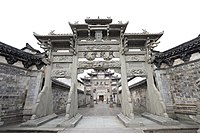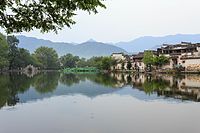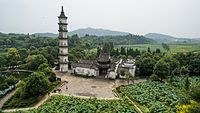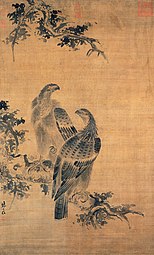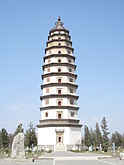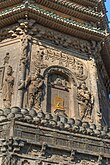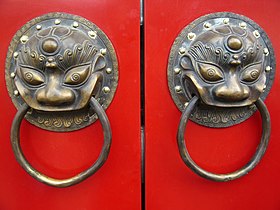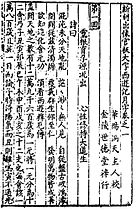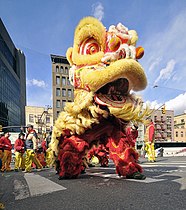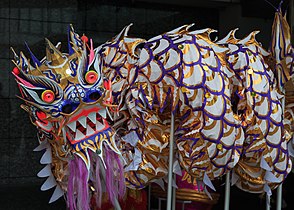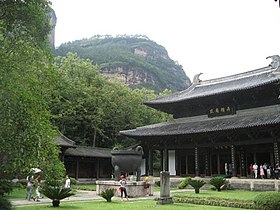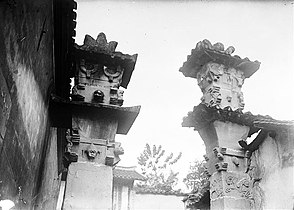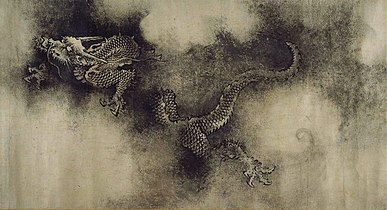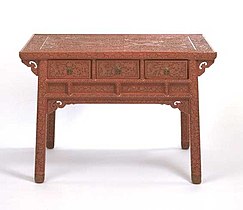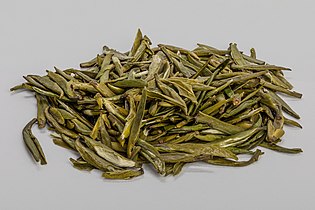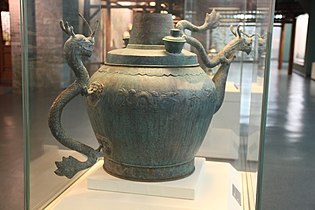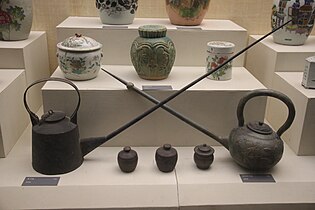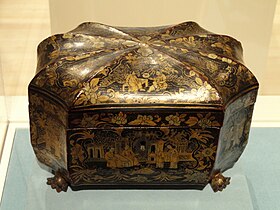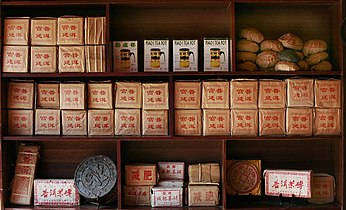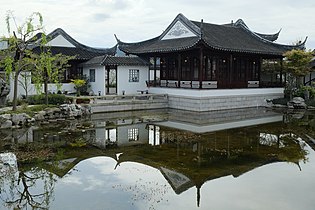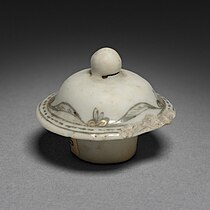Chinese culture
This article has multiple issues.Please helpimprove itor discuss these issues on thetalk page.(Learn how and when to remove these template messages)
|
| Part ofa serieson the |
| Culture of China |
|---|
 |
| Mythologyandfolklore |
| Cuisine |
| Festivals |
| Musicandperforming arts |
Chinese culture(simplified Chinese:Trung hoa văn hóa;traditional Chinese:Trung hoa văn hóa;pinyin:Zhōnghuá wénhuà) is one of the world's oldest cultures, originating thousands of years ago.[1][2]The culture prevails across a large geographical region inEast AsiawithSinospherein whole and is extremely diverse, with customs and traditions varying greatly betweencounties,provinces,cities,towns.The terms 'China' and the geographical landmass of 'China' have shifted across the centuries, before the name 'China' became commonplace in modernity.
Chinese civilization is historically considered a dominant culture of East Asia.[3]WithChinabeing one of theearliest ancient civilizations,Chinese culture exerts profound influence on the philosophy, virtue, etiquette, and traditions ofAsia.[4]Chinese characters,ceramics,architecture,music,dance,literature,martial arts,cuisine,arts,philosophy,etiquette,religion,politics,andhistoryhave had global influence, while itstraditionsandfestivalsare celebrated, instilled, and practiced by people around the world.[5][6][unreliable source?]
Identity
As early as the Zhou dynasty, the Chinese government divided Chinese people intofour classes:gentry,farmer,craftsman,andmerchant.Gentry and farmers constituted the two major classes, while merchant and craftsmen were collected into the two minor. Theoretically, except for the position of the Emperor, nothing was hereditary.[citation needed]
China's majority ethnic group, theHan Chinese,are anEast Asianethnic groupandnation.They constitute approximately 92% of the population of China, 95% ofTaiwan(Han Taiwanese),[7]76% ofSingapore,[8]23% ofMalaysia,and about 17% of theglobal population,making them theworld's largest ethnic group,numbering over 1.3 billion people.
In modern China, there are 56 officially labelledethnic groups.[9]Throughout Chinese history, many non-Han foreigners like the Indo-Iranians became Han Chinese through assimilation, other groups retained their distinct ethnic identities, or faded away.[10]At the same time, the Han Chinese majority has maintained distinct linguistic and regional cultural traditions throughout the ages. The termZhonghua minzu(simplified Chinese:Trung hoa dân tộc;traditional Chinese:Trung hoa dân tộc) has been used to describe the notion ofChinese nationalismin general. Much of the traditional identity within the community has to do with distinguishing thefamily name.
The characteristics of Chinese culture
The chapter discusses the contemporary situations in Chinese culture that relate to social structure, sociocultural change, and the relationship of these factors to the current state of mental health of the Chinese people. The chapter focuses on the issues of mind, body, and behavior. The cultural framework is of central concern to Chinese participants, whether they are social scientists, humanists, or clinical psychiatrists. Chinese culture appears to affect the state of body and health, parent–child interaction, social relationships, individual and group aspirations, models of health care services, and the patterns of disorders and methods of coping under the impact of migration, industrialization, and urbanization. The chapter focuses on the importance of the impact of cultural tradition upon perception, behavioral orientation, pathology, coping, and help-seeking. The mental health concerns that are relevant to the population of mainland China are related to the recent dramatic socialist revolution and particularly to the 10-year period of the Cultural Revolution.[11]
Abstract
Chinese civilization is the only one that has preserved its historical continuity among the world's “cradles for four ancient civilizations.” In the long process of civilization evolution, the Chinese people, in the spirit of “continuous self-renewal,” “self-discipline and social commitment,” “inclusiveness to diversity,” and “realism and adaptation to changes,” created cultural traditions of abundant contents, sophisticated structures, and various forms. These traditions have since been nourishing, nurturing, and shaping the Chinese people and become internalized in the blood and soul of the Chinese nation.[12]
Regional
During the 361 years of civil war after theHan dynasty(202 BC – 220 AD), there was a partial restoration offeudalismwhen wealthy and powerful families emerged with large amounts of land and huge numbers of semi-serfs. They dominated important civilian and military positions of the government, making the positions available to members of their own families and clans.[13][14]TheTang dynastyextended theimperial examinationsystem as an attempt to eradicate this feudalism.[15]Traditional Chinese culture covers large geographical territories, where each region is usually divided into distinct sub-cultures. Each region is often represented by three ancestral items. For example,Guangdongis represented bychenpi,aged gingerandhay.[16][17]The ancient city of Lin'an (Hangzhou), is represented bytea leaf,bamboo shoottrunk,andhickory nut.[18]Such distinctions give rise to the old Chinese proverb: "Thập lí bất đồng phong, bách lí bất đồng tục / thập lí bất đồng phong": "praxis vary within tenli,customs vary within a hundredli".The 31provincial-level divisionsof thePeople's Republic of Chinaare grouped by its former administrative areas from 1949 to 1980, and are now known as traditional regions.
Social structure
Since theThree Sovereigns and Five Emperorsperiod, some form ofChinese monarchhas been the main ruler above all. Different periods of history have different names for the various positions within society. Conceptually each imperial or feudal period is similar, with the government and military officials ranking high in thehierarchy,and the rest of the population under regularChinese law.[19]From the lateZhou dynasty(1046–256 BCE) onwards, traditional Chinese society was organized into a hierarchic system of socio-economic classes known as thefour occupations.
However, this system did not cover all social groups and the distinctions between the groups became blurred after thecommercializationof Chinese culture in theSong dynasty(960–1279 CE).Ancient Chinese educationalso has a long history; ever since theSui dynasty(581–618 CE), educated candidates prepared for the imperial examinations and exam graduates were drafted into government asscholar-bureaucrats.This led to the creation of ameritocracy,although success was available only to males who could afford test preparation. Imperial examinations required applicants to write essays and demonstrate mastery of the Confucian classics. Those who passed the highest level of the exam became elite scholar-officials known asjinshi,a highly esteemed socio-economic position. A major mythological structure developed around the topic of themythology of the imperial exams.Trades and crafts were usually taught by ashifu.The female historianBan Zhaowrote theLessons for Womenin theHan dynastyand outlined thefour virtues women must abide by,while scholars such asZhu XiandCheng Yiwould expand on this.Chinese marriageandTaoist sexual practicesare some of the rituals and customs found in society.[citation needed]
With the rise of European economic and military power beginning in the mid-19th century, non-Chinese systems of social and political organization gained adherents in China. Some of these would-be reformers totally rejected China's cultural legacy, while others sought to combine the strengths of Chinese and European cultures. In essence, the history of 20th-century China is one of experimentation with new systems of social, political, and economic organization that would allow for the reintegration of the nation in the wake of dynastic collapse.[citation needed]
Spiritual values

Most spiritual practices are derived fromChinese Buddhism,TaoismandConfucianism.The relative influence of each school of practice is a subject of debate and other practices, such asNeo-Confucianism,Buddhismand others, have been introduced.[citation needed]Reincarnationand otherrebirthconcepts are a reminder of the connection between real-life and the after-life. In Chinese business culture, the concept ofguanxi,indicating the primacy of relations over rules, has been well documented.[20]While manydeitiesare part of the tradition, some of the most recognized holy figures includeGuan Yin,theJade EmperorandBuddha.
Chinese Buddhism has shaped some Chineseart,literatureandphilosophy.The translation of a large body of foreign Buddhist scriptures into Chinese and the inclusion of these translations, together with works composed in China, into a printed canon had far-reaching implications for the dissemination ofBuddhismthroughout China. Chinese Buddhism is also marked by the interaction betweenIndian religions,Chinese folk religion,andTaoism.
Religion
During the Xia and Shang dynasties, Chinese religion was oriented to worshipping the supreme godShang Di,with the king and diviners acting as priests and usingoracle bones.The Zhou dynasty oriented religion to worshipping the broader concept of heaven. A large part of Chinese culture is based in the belief in a spiritual world. Countlessmethods of divinationhave helped answer questions, even serving as an alternative to medicine.Folkloreshave helped fill the gap between things that cannot be explained. There is often a blurred line between myth, religion and unexplained phenomenon. Many of the stories have since evolved intotraditional Chinese holidays.Other concepts have extended beyond mythology into spiritual symbols such asDoor godand theImperial guardian lions.Along with the belief in the divine beings, there is belief in evil beings. Practices such as Taoistexorcismfightingmogwaiandjiangshiwith peachwood swords are just some of the concepts passed down from generations. A fewChinese fortune tellingrituals are still in use today after thousands of years of refinement.
Taoism, a religious or philosophical tradition ofChineseorigin, emphasizes living in harmony with theTao(Đạo,literally "Way",also romanized asDao). TheTaois a fundamental idea in mostChinese philosophicalschools; in Taoism, however, it denotes the principle that is the source, pattern and substance of everything that exists.[21][22]Taoism differs fromConfucianismby not emphasizing rigid rituals and social order.[21]Taoist ethics vary depending on the particular school, but in general tend to emphasizewu wei(effortless action), "naturalness", simplicity, spontaneity, and theThree Treasures:Từ "compassion", kiệm / kiệm "frugality", and khiêm "humility". The roots of Taoism can be traced back to at least the 4th century BCE. Early Taoism drew its cosmological notions from theSchool of Yinyang(Naturalists), and was deeply influenced by one of China's oldest texts, theYijing,which expounds a philosophical system of human behavior in accordance with the alternating cycles of nature. The "Legalist"Shen Buhaimay also have been a major influence, expounding arealpolitikof wu wei.[22][23][24]TheTao Te Ching,a compact book containing teachings attributed toLaozi(Chinese:Lão tử;pinyin:Lǎozǐ;Wade–Giles:Lao Tzu), is widely considered the keystone work of the Taoist tradition, together with the laterwritings of Zhuangzi.
Philosophy and legalism
Confucianism, also known as Ruism, was the official philosophy throughout most ofImperial China's history, and mastery of Confucian texts was the primary criterion forentry into the imperial bureaucracy.A number of moreauthoritarianstrains of thought have also been influential, such asLegalism.There was often conflict between the philosophies, e.g. theSong dynastyNeo-Confuciansbelieved Legalism departed from the original spirit of Confucianism. Examinations and aculture of meritremain greatly valued in China today.[citation needed]In recent years, a number ofNew Confucians(not to be confused with Neo-Confucianism) have advocated that democratic ideals and human rights are quite compatible with traditional Confucian "Asian values".[25]
Confucianism is described as tradition, a philosophy, a religion, a humanistic or rationalistic religion, a way of governing, or simply a way of life.[26]Confucianism developed from what was later called theHundred Schools of Thoughtfrom the teachings of theChinese philosopherConfucius(551–479 BCE), who considered himself a retransmitter of the values of theZhou dynastygolden age of several centuries before.[27]In theHan dynasty(206 BCE – 220 CE), Confucian approaches edged out the "proto-Taoist"Huang-Lao,as the official ideology, while the emperors mixed both with the realist techniques of Legalism.
Hundred Schools of Thought

The Hundred Schools of Thought were philosophies and schools that flourished from the 6th century to 221 BC, during theSpring and Autumn periodand theWarring States periodof ancient China.[28]While this period was fraught with chaos and bloody battles, it was an era of great cultural and intellectual expansion in China.[29]It came to be known as the Golden Age ofChinese philosophybecause a broad range of thoughts and ideas were developed and could be freely discussed. This phenomenon has been called theContention of a Hundred Schools of Thought( bách gia tranh minh / bách gia tranh minh;bǎijiā zhēngmíng;pai-chia cheng-ming;"hundred schools contend" ). The thoughts and ideas discussed and refined during this period have profoundly influencedlifestylesandsocial consciousnessup to the present day in China and across East Asia. Theintellectualsociety of this era was characterized by itinerant scholars, who were often employed by various state rulers as advisers on the methods of government, war, and diplomacy. This period ended with the rise of the imperialQin dynastyand the subsequentpurge of dissent.A traditional source for this period is theShiji,orRecords of the Grand HistorianbySima Qian.The autobiographical section of theShiji,the "Taishigong Zixu" ( thái sử công tự tự ), refers to the schools of thought described below.
Mohism was anancient Chinese philosophyoflogic,rationalthought andsciencedeveloped by theacademicscholarswho studied under the ancient Chinese philosopherMozi(c. 470 BC–c. 391 BC). The philosophy is embodied in an eponymous book: theMozi.Another group is the School of the Military ( binh gia;Bingjia) that studied warfare and strategy;SunziandSun Binwere influential leaders. The School of Naturalists was aWarring Statesera philosophy that synthesized the concepts ofyin-yangand theFive Elements;Zou Yanis considered the founder of this school.[30]His theory attempted to explain the universe in terms of basic forces in nature: the complementary agents of yin (dark, cold, female, negative) and yang (light, hot, male, positive) and the Five Elements or Five Phases (water, fire, wood, metal, and earth).
Language
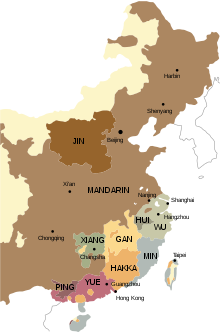
The ancient written standard wasClassical Chinese.It was used for thousands of years, but was mostly used by scholars and intellectuals in the upper class society called "shi da fu ( sĩ đại phu )". It was difficult, but possible, for ordinary people to enter this class by passing written exams. Calligraphy later became commercialized, and works by famous artists became prized possessions.Chinese literaturehas a long past; the earliest classic work in Chinese, theI Chingor "Book of Changes", dates to around 1000 BC. A flourishing of philosophy during theWarring States periodproduced such noteworthy works as Confucius'sAnalectsandLaozi'sTao Te Ching.(See also:Chinese classics) Dynastic histories were often written, beginning withSima Qian's seminalRecords of the Grand Historian,written from 109 BC to 91 BC. The Tang dynasty witnessed apoeticflowering, while theFour Great Classical Novelsof Chinese literature were written during the Ming and Qing dynasties.Printmakingin the form ofmovable typewas developed during theSong dynasty.Academies of scholars sponsored by the empire were formed to comment on the classics in both printed and handwritten form. Members of royalty frequently participated in these discussions.
Chinese philosophers, writers and poets were highly respected and played key roles in preserving and promoting the culture of the empire. Some classical scholars, however, were noted for their daring depictions of the lives of the common people, often to the displeasure of authorities.
Varieties of dialect and writing system
At the start of the 20th century, most of the population were stillilliterate,and the many languages spoken (Mandarin,Wu,Yue(Cantonese),Min Nan(Ban-lam-gu),Jin,Xiang,Hakka,Gan,Hui,Pingetc.) in different regions prevented spoken communication with people from other areas. However, the written language made communication possible, such as passing on official orders and documents throughout the entire region of China. Reformers set out to establish a national language, settling on the Beijing-basedMandarinas the spoken form. After theMay 4th Movement,Classical Chinese was quickly replaced bywritten vernacular Chinese,modeled after the vocabulary and grammar of the standard spoken language.[32]
Calligraphy

Chinese calligraphy is a form of writing (calligraphy), or, the artistic expression of human language in a tangible form. There are some general standardizations of the variousstylesof calligraphy in this tradition. Chinese calligraphy andink and wash paintingare closely related: they are accomplished using similar tools and techniques, and have a long history of shared artistry. Distinguishing features of Chinese painting and calligraphy include an emphasis on motion charged with dynamic life. According to Stanley-Baker, "Calligraphy is sheer life experienced through energy in motion that is registered as traces on silk or paper, with time and rhythm in shifting space its main ingredients."[33]Calligraphy has also led to the development of many forms of art in China, includingsealcarving, ornate paperweights, andinkstones.

In China, calligraphy is referred to asShūfǎ( thư pháp / thư pháp ), literally "the way/method/law of writing".[34]In Japan it is referred to asShodō(Thư đạo / thư đạo), literally "the way/principle of writing"; and in Korea asSeoye(서예; thư nghệ ) literally "the skill/criterion[35]of writing ". Chinese calligraphy is normally regarded as one of the" arts "(Chinese nghệ thuật / nghệ thuậtpinyin:yìshù) in the countries where it is practised. Chinese calligraphy focuses not only on methods of writing but also on cultivating one's character ( nhân phẩm )[36]and taught as a discipline ( thư pháp;pinyin:shūfǎ,"the rules of writingHan characters"[37]).
Literature
TheZhou dynastyis often regarded as the touchstone of Chinese cultural development. Concepts covered in theChinese classic textsincludepoetry,astrology,astronomy,thecalendar,andconstellations.Some of the most important early texts include theI Chingand theShujingwithin theFour Books and Five Classics.Many Chinese concepts such asYin and Yang,Qi,Four Pillars of Destinyin relation to heaven and earth were theorized in the pre-imperial periods. By the end of the Qing dynasty, Chinese culture had embarked on a new era withwritten vernacular Chinesefor the common citizens.Hu ShihandLu Xunwere considered pioneers in modern literature at that time. After the founding of thePeople's Republic of China,the study of Chinese modern literature gradually increased. Modern-era literature has influenced modern interpretations of nationhood and the creation of a sense of national spirit.[citation needed]
Poetry in the Tang dynasty
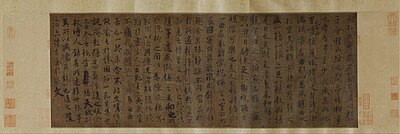
Tang poetry refers topoetrywritten in or around the time of, or in the characteristic style of, China'sTang dynasty(18 June 618 – 4 June 907, including the 690–705 reign ofWu Zetian) or that follows a certain style, often considered theGolden AgeofChinese poetry.During the Tang dynasty, poetry continued to be an important part of social life at all levels of society. Scholars were required to master poetry for the civil service exams, but the art was theoretically available to everyone.[38]This led to a large record of poetry and poets, a partial record of which survives today. Two of the most famous poets of the period wereLi BaiandDu Fu.Tang poetry has had an ongoing influence on world literature and modern and quasi-modern poetry. TheQuantangshi( "Complete Tang Poems" ) anthology compiled in the early eighteenth century includes over 48,900 poems written by over 2,200 authors.[39]
TheQuantangwen( toàn đường văn, "Complete Tang Prose" ), despite its name, contains more than 1,500fuand is another widely consulted source for Tang poetry.[39]Despite their names, these sources are not comprehensive, and themanuscripts discovered at Dunhuangin the twentieth century included manyshiand somefu,as well as variant readings of poems that were also included in the later anthologies.[39]There are also collections of individual poets' work, which generally can be dated earlier than the Qing anthologies, although few earlier than the eleventh century.[40]Only about a hundred Tang poets have such collected editions extant.[40]Another important source is anthologies of poetry compiled during the Tang dynasty, although only thirteen such anthologies survive in full or in part.[41]Many records of poetry, as well as other writings, were lost when the Tang capital ofChanganwas damaged by war in the eighth and ninth centuries, so that while more than 50,000 Tang poems survive (more than any earlier period in Chinese history), this still likely represents only a small portion of the poetry that was actually produced during the period.[40]Many seventh-century poets are reported by the 721 imperial library catalog as having left behind massive volumes of poetry, of which only a tiny portion survives,[40]and there are notable gaps in the poetic œuvres of even Li Bai and Du Fu, the two most celebrated Tang poets.[40]
Ciin Song dynasty
Ci ( từ / từ ) are a poetic form, a type oflyric poetry,done in the tradition ofClassical Chinese poetry.Ciuse a set ofpoetic metersderived from a base set of certain patterns, in fixed-rhythm, fixed-tone, and variable line-length formal types, or model examples: the rhythmic and tonal pattern of theciare based upon certain, definitive musical song tunes. They are also known asChangduanju( trường đoản cú / trường đoản cú, "lines of irregular lengths" ) andShiyu( thi dư / thi dư, "that which is beside poetry" ).Typically the number ofcharactersin each line and the arrangement oftoneswere determined by one of around 800 set patterns, each associated with a particular title, calledcípáiTừ bài / từ bài. Originally they were written to be sung to a tune of that title, with set rhythm,rhyme,and tempo. TheSong dynastywas also a period of great scientific literature, and saw the creation of works such asSu Song'sXin Yixiang FayaoandShen Kuo'sDream Pool Essays.There were also enormous works of historiography and large encyclopedias, such asSima Guang'sZizhi Tongjianof 1084 or theFour Great Books of Songfully compiled and edited by the 11th century.
Notable Confucianists,Taoistsand scholars of all classes have made significant contributions to and from documenting history to authoring saintly concepts that seem hundreds of years ahead of time. Although the oldest surviving textual examples of survivingciare from 8th century CEDunhuang manuscripts,[42]beginning in thepoetryof theLiang dynasty,thecifollowed the tradition of theShi Jingand theyuefu:they were lyrics which developed from anonymous popular songs into a sophisticated literary genre; although in the case of theciform some of its fixed-rhythm patterns have an origin inCentral Asia.The form was further developed in theTang dynasty.Although the contributions ofLi Bo(also known as Li Po, 701 – 762) are fraught with historical doubt, certainly the Tang poetWen Tingyun(812–870) was a great master of theci,writing it in its distinct and mature form.[43]One of the more notable practitioners and developers of this form wasLi Yuof theSouthern Tangdynasty during theFive Dynasties and Ten Kingdoms period.However, theciform of Classical Chinese poetry is especially associated with thepoetry of the Song dynasty,during which it was indeed a popular poetic form. A revival of thecipoetry form occurred during the end of theMing dynastyand the beginning of theQing dynastywhich was characterized by an exploration of the emotions connected with romantic love together with its valorization, often in a context of a brief poetic story narrative within acipoem or a linked group ofcipoems in an application of thechuanqiform of short story tales to poetry.[44]
Quin Yuan dynasty
TheQuform of poetry is a type ofClassical Chinese poetry form,consisting of words written in one of a number of certain, settone patterns,based upon the tunes of various songs. ThusQupoems are lyrics with lines of varying longer and shorter lengths, set according to the certain and specific, fixed patterns of rhyme and tone of conventional musical pieces upon which they are based and after which these matched variations in lyrics (or individualQupoems) generally take their name.[45]The fixed-tone type of verse such as theQuand thecitogether with theshiandfuforms of poetry comprise the three main forms ofClassical Chinese poetry.InChinese literature,theQu(Chinese:Khúc;pinyin:qǔ;Wade–Giles:chü) form of poetry from theYuan dynastymay be calledYuanqu( nguyên khúc P:Yuánqǔ,W:Yüan-chü). Qu may be derived fromChinese opera,such as theZaju( tạp kịch / tạp kịch ), in which case these Qu may be referred to assanqu( tán khúc ). TheSaninSanqurefers to the detached status of theQulyrics of this verse form: in other words, rather than being embedded as part of an opera performance the lyrics stand separately on their own. Since theQubecame popular during the lateSouthern Songdynasty, and reached a special height of popularity in thepoetryof the Yuan dynasty, therefore it is often calledYuanqu( nguyên khúc ), specifying the type ofQufound inChinese operatypical of the Yuan dynasty era. BothSanquandCiare lyrics written to fit a different melodies, butSanqudiffers fromCiin that it is more colloquial, and is allowed to containChenzi( sấn tự / sấn tự "filler words" which are additional words to make a more complete meaning).Sanqucan be further divided intoXiaoling( tiểu lệnh ) andSantao( tán sáo ), with the latter containing more than one melody.
The novels in Ming dynasty and Qing dynasty
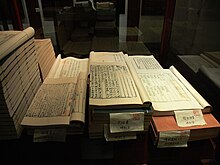
The Four Great Classical[46]or Classic Novels ofChinese literature[47][a]are the fournovelscommonly regarded by Chinese literary criticism to be the greatest and most influential of pre-modern Chinese fiction. Dating from theMingandQingdynasties, they are well known to most Chinese either directly or through their many adaptations toChinese operaand other forms ofpopular culture.They are among the world's longest and oldest novels and are considered to be the pinnacle of China's literary achievement in classic novels, influencing the creation of many stories, plays, movies, games, and other forms of entertainment across other parts of East Asia.
Chinese fiction, rooted in narrative classics such asShishuo Xinyu,Sou Shen Ji,Wenyuan Yinghua,Da Tang Xiyu Ji,Youyang Zazu,Taiping Guangji,and official histories, developed into thenovelas early as theSong dynasty.The novel as an extended prose narrative which realistically creates a believable world of its own evolved in China and in Europe from the 14th to 18th centuries, though a little earlier in China. Chinese audiences were more interested in history and were more historically minded. They appreciated relative optimism, moral humanism, and relative emphasis on collective behavior and the welfare of the society.[49]
The rise of a money economy and urbanization beginning in the Song era led to a professionalization of entertainment which was further encouraged by the spread of printing, the rise of literacy, and education. In both China and Western Europe, the novel gradually became more autobiographical and serious in exploration of social, moral, and philosophical problems. Chinese fiction of the lateMing dynastyand earlyQing dynastywas varied, self-conscious, and experimental. In China, however, there was no counterpart to the 19th-century European explosion of novels. The novels of the Ming and early Qing dynasties represented a pinnacle of classic Chinese fiction.[50]The scholar and literary criticAndrew H. Plaksargues thatRomance of the Three Kingdoms,Water Margin,Journey to the West,andThe Golden Lotuscollectively constituted a technical breakthrough reflecting new cultural values and intellectual concerns. Their educated editors, authors, and commentators used thenarrative conventionsdeveloped fromearlier story-tellers,such as the episodic structure, interspersed songs and folk sayings, or speaking directly to the reader, but they fashioned self-consciously ironic narratives whose seeming familiarity camouflaged a Neo-Confucian moral critique of late Ming decadence. Plaks explores the textual history of the novels (all published after their author's deaths, usually anonymously) and how the ironic and satiric devices of these novels paved the way for the great novels of the 18th century.[51]Plaks further shows these Ming novels share formal characteristics.
Fashion and clothing
China's fashion history covers hundreds of years with some of the most colorful and diverse arrangements. Different social classes in different eras boast different fashion trends, the color yellow was usually reserved for the emperor during China's Imperial era.
Pre-Qing
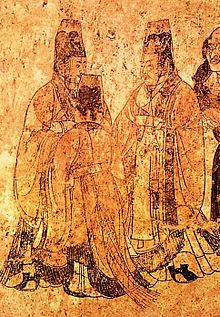
From the beginning of its history,Han clothing(especially in elite circles) was inseparable fromsilk,supposedly discovered by theYellow Emperor'sconsort,Leizu.The dynasty to follow the Shang, theWestern Zhou dynasty,established a strict hierarchical society that used clothing as a status meridian, and inevitably, the height of one's rank influenced the ornateness of a costume. Such markers included the length of a skirt, the wideness of a sleeve and the degree of ornamentation. In addition to these class-oriented developments, Han Chinese clothing became looser, with the introduction of wide sleeves and jade decorations hung from the sash which served to keep theyiclosed. Theyiwas essentially wrapped over, in a style known asjiaoling youren,or wrapping the right side over before the left, because of the initially greater challenge to the right-handed wearer (people of Zhongyuan discouragedleft-handednesslike many other historical cultures, considering it unnatural, barbarian, uncivilized, and unfortunate). TheShang dynasty(c. 1600 BC– 1046 BC), developed the rudiments of Chinese clothing; it consisted of ayi,a narrow-cuffed, knee-length tunic tied with a sash, and a narrow, ankle-length skirt, calledchang,worn with abixi,a length of fabric that reached the knees. Vivid primary colors and green were used, due to the degree of technology at the time.
Qipao
During theQing dynasty,China's last imperial dynasty, a dramatic shift of clothing occurred, examples of which include thecheongsam(or qipao in Mandarin). The clothing of the era before the Qing dynasty is referred to asHanfuor traditionalHan Chinese clothing.Many symbols such asphoenixhave been used for decorative as well as economic purposes. Among them were theBanners(qí), mostly Manchu, who as a group were calledBanner People(Kỳ nhânpinyin:qí rén).Manchuwomen typically wore a one-piece dress that retrospectively came to be known as theqípáo(Kỳ bào,Manchu:sijigiyanorbanner gown). The generic term for both the male and the female forms of Manchu dress, essentially similar garments, waschángpáo(Trường bào/ trường bào ). Theqipaofitted loosely and hung straight down the body, or flared slightly in an A-line. Under the dynastic laws after 1636, allHan Chinesein the banner system were forced to adopt the Manchu male hairstyle of wearing aqueueas did all Manchu men and dress in Manchuqipao.However, the order for ordinary non-Banner Han civilians to wear Manchu clothing was lifted and only Han who served as officials were required to wear Manchu clothing, with the rest of the civilian Han population dressing however they wanted. Qipao covered most of the woman's body, revealing only the head, hands, and the tips of the toes. The baggy nature of the clothing also served to conceal the figure of the wearer regardless of age. With time, though, theqipaowere tailored to become more form fitting and revealing. The modern version, which is now recognized popularly in China as the "standard"qipao,was first developed inShanghaiin the 1920s, partly under the influence of Beijing styles. People eagerly sought a more modernized style of dress and transformed the oldqipaoto suit their tastes. Slender and form fitting with a high cut, it had great differences from the traditionalqipao.It was high-classcourtesansand celebrities in the city that would make these redesigned tight fittingqipaopopular at that time. In Shanghai it was first known aszansaeor "long dress" ( trường sam —Mandarin Chinese: chángshān;Shanghainese:zansae;Cantonese:chèuhngsāam), and it is this name that survives in English as the "cheongsam". Most Han civilian men eventually voluntarily adopted Manchu clothing while Han women continued wearing Han clothing. Until 1911, the changpao was required clothing for Chinese men of a certain class, but Han Chinese women continued to wear loose jacket and trousers, with an overskirt for formal occasions. Theqipaowas a new fashion item for Han Chinese women when they started wearing it around 1925.The originalqipaowas wide and loose. As hosiery in turn declined in later decades, cheongsams nowadays have come to be most commonly worn with bare legs.
Arts
Chinese art isvisual artthat, whether ancient or modern, originated in or is practiced in China or by Chinese artists. The Chinese art in theRepublic of China(Taiwan) and that ofoverseas Chinesecan also be considered part of Chinese art where it is based in or draws on Chinese heritage and Chinese culture. Early "Stone Ageart "dates back to 10,000 BC, mostly consisting of simplepotteryand sculptures. After this early period Chinese art, like Chinese history, is typically classified by the succession of rulingdynastiesofChinese emperors,most of which lasted several hundred years.
Chinese art has arguably the oldest continuous tradition in the world, and is marked by an unusual degree of continuity within, and consciousness of, that tradition, lacking an equivalent to the Western collapse and gradual recovery of classical styles. The media that have usually been classified in the West since theRenaissanceas thedecorative artsare extremely important in Chinese art, and much of the finest work was produced in large workshops or factories by essentially unknown artists, especially inChinese ceramics.
Different forms of art have swayed under the influence of great philosophers, teachers, religious figures and even political figures. Chinese art encompasses all facets offine art,folk artandperformance art.Porcelain potterywas one of the first forms of art in thePalaeolithicperiod. Early Chinese music and poetry was influenced by theBook of Songs,and the Chinese poet and statesmanQu Yuan.
Chinese paintingbecame a highly appreciated art in court circles encompassing a wide variety ofShan shuiwith specialized styles such asMing dynasty painting.EarlyChinese musicwas based on percussion instruments, which later gave away to stringed and reed instruments. By theHan dynastypapercuttingbecame a new art form after the invention of paper.Chinese operawould also be introduced and branched regionally in addition to other performance formats such asvariety arts.
Chinese lantern

The Chinese paper lantern ( chỉ đăng lung, chỉ đăng lung ) is alanternmade of thin, brightly colored paper.[52]Paper lanterns come in various shapes and sizes, as well as various methods of construction. In their simplest form, they are simply apaper bagwith acandleplaced inside, although more complicatedlanternsconsist of a collapsiblebambooor metal frame of hoops covered with toughpaper.Sometimes, other lanterns can be made out of colored silk (usually red) or vinyl. Silk lanterns are also collapsible with a metal expander and are decorated with Chinese characters and/or designs. The vinyl lanterns are more durable; they can resist rain, sunlight, and wind. Paper lanterns do not last very long, they soon break, and silk lanterns last longer. The gold paper on them will soon fade away to a pale white, and the red silk will become a mix between pink and red. Often associated withfestivals,paper lanterns are common in China, Japan, Korea, Taiwan, and similarly inChinatownswith large communities ofOverseas Chinese,where they are often hung outside of businesses to attract attention. In Japanthe traditional stylesincludebonboriandchōchinand there is a special style of lettering calledchōchin mojiused to write on them. Airborne paper lanterns are calledsky lanterns,and are often released into the night sky for aesthetic effect atlantern festivals.
The Chinese sky lantern ( thiên đăng, thiên đăng ), also known asKongming lantern,is a smallhot air balloonmade of paper, with an opening at the bottom where a small fire is suspended. In Asia and elsewhere around the world, sky lanterns have been traditionally made for centuries, to be launched for play or as part of long-established festivities. The name "sky lantern" is a translation of theChinesename but they have also been referred to assky candlesorfire balloons.The general design is a thin paper shell, which may be from about 30cmto a couple ofmetresacross, with an opening at the bottom. The opening is usually about 10 to 30 cm wide (even for the largest shells), and is surrounded by a stiff collar that serves to suspend theflamesource and to keep it away from the walls. When lit, the flame heats the air inside the lantern, thus lowering its density and causing the lantern to rise into the air. The sky lantern is only airborne for as long as the flame stays alight, after which the lantern sinks back to the ground.
Chinese hand fan

The oldest existing Chinese fans are a pair of wovenbamboo,wood or paper side-mounted fans from the 2nd century BCE.[53]TheChinese characterfor "fan" ( phiến ) is etymologically derived from a picture of feathers under a roof. A particular status and gender would be associated with a specific type of fan. During theSong dynasty,famous artists were often commissioned to paint fans. The Chinese dancing fan was developed in the 7th century. The Chinese form of the hand fan was a row of feathers mounted in the end of a handle. In the later centuries, Chinese poems and four-word idioms were used to decorate the fans by using Chinese calligraphy pens. In ancient China, fans came in various shapes and forms (such as in a leaf, oval or a half-moon shape), and were made in different materials such as silk, bamboo, feathers, etc.[54]
Carved lacquer
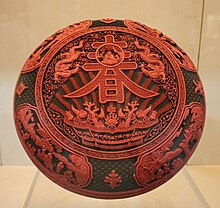
Carved lacquer orQīdiāo(Chinese:Tất điêu) is a distinctive Chinese form of decoratedlacquerware.While lacquer has been used in China for at least 3,000 years,[55]the technique of carving into very thick coatings of it appears to have been developed in the 12th century CE. It is extremely time-consuming to produce, and has always been a luxury product, essentially restricted to China,[56]though imitated inJapanese lacquerin somewhat different styles. The producing process is calledDiāoqī(Điêu tất/ điêu tất, carving lacquer).Though most surviving examples are from theMingandQingdynasties, the main types of subject matter for the carvings were all begun under theSong dynasty,and the development of both these and the technique of carving were essentially over by the early Ming. These types were the abstractgurior Sword-Pommel pattern, figures in a landscape, and birds and plants. To these some designs with religious symbols, animals, auspicious characters(right)and imperial dragons can be added.[55]The objects made in the technique are a wide range of small types, but are mostly practical vessels or containers such as boxes, plates and trays. Some screens and pieces ofChinese furniturewere made. Carved lacquer is only rarely combined with painting in lacquer and other lacquer techniques.[57]
Later Chinese writers dated the introduction of carved lacquer to theTang dynasty(618–906), and many modern writers have pointed to some late Tang pieces of armour found on theSilk RoadbyAurel Steinand now in theBritish Museum.These are red and black lacquer oncamelhide, but the lacquer is very thin, "less than one millimeter in thickness", and the effect very different, with simple abstract shapes on a plain field and almost no impression ofrelief.[58][59][60]The style of carving into thick lacquer used later is first seen in theSouthern Song(1127–1279), following the development of techniques for making very thick lacquer.[61]There is some evidence from literary sources that it had existed in the late Tang.[62]At first the style of decoration used is known asguri(Khuất luân/ khúc luân ) from the Japanese word for the ring-pommel of a sword, where the same motifs were used in metal, and is often called the "Sword-Pommel pattern" in English. This style uses a family of repeated two-branched scrolling shapes cut with a rounded profile at the surface, but below that a "V" section through layers of lacquer in different colours (black, red and yellow, and later green), giving a "marbled" effect from the contrasted colours; this technique is calledtìxī(Dịch tê/ thế tê ) in Chinese. This style continued to be used up to theMing dynasty,especially on small boxes and jars with covers, though after the Song only red was often used, and the motifs were often carved with wider flat spaces at the bottom level to be exposed.[63]
Folding screen

A folding screen (simplified Chinese:Bình phong;traditional Chinese:Bình phong) is a type of free-standingfurniture.It consists of several frames or panels, which are often connected byhingesor by other means. It can be made in a variety of designs and with different kinds of materials. Folding screens have many practical and decorative uses. It originated fromancient China,eventually spreading to the rest of East Asia, Europe, and other parts of the world. Screens date back to China during the EasternZhouperiod (771–256 BCE).[64][65]These were initially one-panel screens in contrast to folding screens.[66]Folding screens were invented during theHan dynasty(206 BCE – 220 CE).[67]Depictions of those folding screens have been found in Han-era tombs, such as one inZhucheng,Shandong Province.[64]
Folding screens were originally made from wooden panels and painted onlacqueredsurfaces, eventually folding screens made from paper orsilkbecame popular too.[66]Even though folding screens were known to have been used sinceantiquity,it became rapidly popular during theTang dynasty(618–907).[68]During the Tang dynasty, folding screens were considered ideal ornaments for many painters to display theirpaintingsandcalligraphyon.[65][66]Many artists painted on paper or silk and applied it onto the folding screen.[65]There were two distinct artistic folding screens mentioned in historical literature of the era. One of it was known as thehuaping(simplified Chinese:Họa bình;traditional Chinese:Họa bình;lit.'painted folding screen') and the other was known as theshuping(simplified Chinese:Thư bình;traditional Chinese:Thư bình;lit.'calligraphed folding screen').[66][68]It was not uncommon for people to commission folding screens from artists, such as from Tang-era painter Cao Ba orSong-erapainterGuo Xi.[65]The landscape paintings on folding screens reached its height during the Song dynasty (960–1279).[64]Thelacquer techniquesfor theCoromandel screens,which is known askuǎncǎi(Khoản thải"incised colors" ),[69]emerged during the lateMing dynasty(1368–1644)[70]and was applied to folding screens to create dark screens incised, painted, and inlaid with art ofmother-of-pearl,ivory, or other materials.
Chinese jade

Chinese jade ( ngọc ) refers to thejademinedorcarvedin China from theNeolithiconward. It is the primaryhardstoneofChinese sculpture.Although deep and bright greenjadeiteis better known in Europe, for most of China's history, jade has come in a variety of colors and white "mutton-fat"nephritewas the most highly praised and prized. Native sources inHenanand along theYangtzewere exploited since prehistoric times and have largely been exhausted; most Chinese jade today is extracted from the northwesternprovinceofXinjiang.Jade was prized for itshardness,durability,musical qualities,and beauty.[71]In particular, its subtle, translucent colors and protective qualities[71]caused it to become associated with Chinese conceptions of thesoulandimmortality.[72]The most prominent early use was the crafting of theSix Ritual Jades,found since the 3rd-millennium BCLiangzhu culture:thebi,thecong,thehuang,thehu,thegui,and thezhang.[73]Although these items are so ancient that their original meaning is uncertain, by the time of the composition of theRites of Zhou,they were thought to represent thesky,theearth,and thefour directions.By theHan dynasty,the royal family and prominent lords were buried entirely ensheathed injade burial suitssewn in gold thread, on the idea that it would preserve the body and the souls attached to it. Jade was also thought to combat fatigue in the living.[71]The Han also greatly improved prior artistic treatment of jade.[74]These uses gave way after theThree Kingdoms periodtoBuddhistpractices and new developments inTaoismsuch asalchemy.Nonetheless, jade remained part oftraditional Chinese medicineand an important artistic medium. Although its use never became widespread inJapan,jade became important to the art ofKoreaand Southeast Asia.
Mythological beings
Loong

Loongs, also known as Chinese Dragon, arelegendary creaturesinChinese mythology,Chinese folklore,and East Asian culture. Chinese dragons have manyanimal-like formssuch asturtlesandfish,but are most commonly depicted assnake-like with four legs. They traditionally symbolize potent andauspiciouspowers, particularly control over water, rainfall, typhoons, and floods. The dragon is also a symbol of power, strength, and good luck for people who are worthy of it. During the days of Imperial China, theEmperor of Chinausually used the dragon as a symbol of his imperial power and strength.[75][unreliable source?]They are also the symbol and representative for theSon of Heaven,theMandate of Heaven,theCelestial Empireand theChinese Tributary Systemduring thehistory of China.
Fenghuang

Fenghuang ( phượng hoàng ) aremythologicalbirds found in Chinese and East Asian mythology that reign over all other birds. Themaleswere originally calledfengand thefemaleshuangbut such a distinction of gender is often no longer made and they are blurred into a single feminine entity so that the bird can be paired with theChinese dragon,which is traditionally deemed male. The fenghuang is also called the "August Rooster" (simplified Chinese:Côn kê;traditional Chinese:鶤 kê or côn kê;pinyin:yùnjī or kūnjī;Wade–Giles:yün4-chi1or k'un1-chi1) since it sometimes takes the place of theRoosterin theChinese zodiac.[citation needed]In the Western world, it is commonly called the Chinese phoenix or simply Phoenix, although mythological similarities with the Westernphoenixare superficial[citation needed].
Qilin

The Qilin ([tɕʰǐ.lǐn];Chinese:Kỳ lân), or Kirin in Japanese, is amythicalhoovedchimericalcreature in Chinese culture, said to appear with the imminent arrival or passing of asageor illustrious ruler.[76]Qilin is a specific type of thelinmythological family of one-horned beasts. The earliest references to theqilinare in the 5th century BCZuo Zhuan.[77][78]Theqilinmade appearances in a variety of subsequent Chinese works of history and fiction, such asFeng Shen Bang.Emperor Wu of Hanapparently captured a liveqilinin 122 BC, althoughSima Qianwas skeptical of this.[79][better source needed]
Xuanwu
Xuanwu (Chinese:Huyền võ ) is one of theFour Symbolsof theChinese constellations.Despite its English name, it is usually depicted as aturtleentwined together with asnake.It is known as Genbu inJapaneseand Hyeonmu inKorean.It represents thenorthand thewinterseason. In Japan, it is one of the four guardian spirits that protect Kyoto and it is said that it protects the city on the north. Represented by theKenkun Shrine,which is located on top of Mt Funaoka in Kyoto. The creature's name is identical to that of the importantTaoistgodXuanwu,who is sometimes (as inJourney to the West) portrayed in the company of a turtle and snake.
Music, instruments and dancing
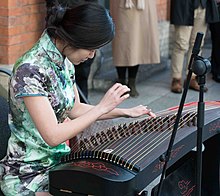
Music and dance were closely associated in the very early periods of China. Themusicof China dates back to thedawn of Chinese civilizationwith documents and artifacts providing evidence of a well-developed musical culture as early as theZhou dynasty(1122 BCE – 256 BCE). The earliest music of the Zhou dynasty recorded in ancient Chinese texts includes the ritual music calledyayueand each piece may be associated with a dance. Some of the oldest written music dates back toConfucius's time. The first major well-documented flowering of Chinese music was exemplified through the popularization of theqin(plucked instrument with seven strings) during theTang dynasty,although the instrument is known to have played a major role before the Han dynasty.
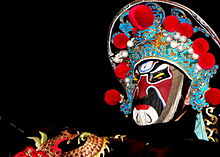
There are manymusical instrumentsthat are integral to Chinese culture, such as theXun(Ocarina-type instrument that is also integral in Native American cultures),Guzheng(zither with movable bridges),guqin(bridgeless zither),shengandxiao(vertical flute), theerhu(alto fiddle or bowed lute),pipa(pear-shaped plucked lute), and many others.
Dance in China is a highly varied art form, consisting of many modern and traditional dance genres. The dances cover a wide range, from folk dances to performances in opera and ballet, and may be used in public celebrations, rituals and ceremonies. There are also 56 officially recognizedethnic groups in China,and each ethnic minority group in China also has its own folk dances. The best known Chinese dances today are theDragon danceand theLion Dance.
Architecture
Chinese architecture is a style ofarchitecturethat has taken shape through the ages and influenced the architecture of East Asia for many centuries. The structural principles of Chinese architecture have remained largely unchanged, the main changes being only the decorative details. Since the Tang dynasty, Chinese architecture has had a major influence on the architectural styles of East Asia such asJapanandKorea.Chinese architecture, examples for which can be found from more than 2,000 years ago, is almost as old as Chinese civilization and has long been an important hallmark of Chinese culture. There are certain features common to Chinese architecture, regardless of specific regions, different provinces or use. The most important issymmetry,which connotes a sense of grandeur as it applies to everything from palaces to farmhouses. One notable exception is in the design of gardens, which tends to be as asymmetrical as possible. Like Chinese scroll paintings, the principle underlying the garden's composition is to create enduring flow, to let the patron wander and enjoy the garden without prescription, as in nature herself.Feng shuihas played a very important part in structural development. The Chinese garden is a landscape garden style which has evolved over three thousand years. It includes both the vast gardens of theChinese emperorsand members of the imperial family, built for pleasure and to impress, and the more intimate gardens created by scholars, poets, former government officials, soldiers and merchants, made for reflection and escape from the outside world. They create an idealized miniature landscape, which is meant to express the harmony that should exist betweenman and nature.[80]A typical Chinese garden is enclosed by walls and includes one or more ponds, rock works, trees and flowers, and an assortment of halls and pavilions within the garden, connected by winding paths and zig-zag galleries. By moving from structure to structure, visitors can view a series of carefully composed scenes, unrolling like a scroll of landscape paintings.
Chinese palace
The Chinese palace is an imperial complex where the royal court and the civil government resided. Its structures are considerable and elaborate. The Chinese charactergong( cung; meaning "palace" ) represents two connected rooms ( lữ ) under a roof ( miên ). Originally the character applied to any residence or mansion, but it was used in reference to solely the imperial residence since theQin dynasty(3rd century BC). A Chinese palace is composed of many buildings. It has large areas surrounded by walls and moats. It contains large halls ( điện ) for ceremonies and official business, as well as smaller buildings,temples,towers, residences, galleries, courtyards,gardens,and outbuildings. Apart from the main imperial palace,Chinese dynastiesalso had several other imperial palaces in the capital city where the empress, crown prince, or other members of the imperial family dwelled. There also existed palaces outside of the capital city called "away palaces" ( ly cung / ly cung ) where the emperors resided when traveling. Empress dowagerCixi( từ hi thái hậu ) built theSummer Palaceor Yiheyuan ( di hòa viên / di hòa viên – "The Garden of Nurtured Harmony" ) near theOld Summer Palace,but on a much smaller scale than the Old Summer Palace.[b]
Paifang
Paifang,also known as aPailou,is a traditional style ofChinesearchitecturalarchor gateway structure that is related to theIndianToranafrom which it is derived.[81]The wordpaifang(Chinese:Bài phường;pinyin:páifāng) was originally a collective term for the top two levels of administrative division and subdivisions of ancient Chinese cities. The largest division within a city in ancient China was afang(Phường;fāng), equivalent to a current dayward.Each fang was enclosed by walls or fences, and the gates of these enclosures were shut and guarded every night. Each fang was further divided into severalpai(Bài;pái;'placard'), which is equivalent to a current day (unincorporated) community. Each pai, in turn, contained an area including severalhutongs(alleyways). This system of urban administrative division and subdivision reached an elaborate level during theTang dynasty,and continued in the following dynasties. For example, during theMing dynasty,Beijingwas divided into a total of 36 fangs. Originally, the wordpaifangreferred to the gate of a fang and the marker for an entrance of a building complex or a town; but by theSong dynasty,a paifang had evolved into a purely decorative monument.
Chinese garden

The Chinese garden is a landscape garden style which has evolved over the years.[82]It includes both the vast gardens of theChinese emperorsand members of the imperial family, built for pleasure and to impress, and the more intimate gardens created by scholars, poets, former government officials, soldiers and merchants, made for reflection and escape from the outside world. They create an idealized miniature landscape, which is meant to express the harmony that should exist between man and nature.[80]A typical Chinese garden is enclosed by walls and includes one or more ponds, rock works, trees and flowers, and an assortment of halls and pavilions within the garden, connected by winding paths and zig-zag galleries. By moving from structure to structure, visitors can view a series of carefully composed scenes, unrolling like a scroll of landscape paintings. The earliest recorded Chinese gardens were created in the valley of theYellow River,during theShang dynasty(1600–1046 BC). These gardens were large enclosed parks where the kings and nobles hunted game, or where fruit and vegetables were grown. Early inscriptions from this period, carved on tortoise shells, have three Chinese characters for garden,you,puandyuan.Youwas a royal garden where birds and animals were kept, while pu was a garden for plants. During theQin dynasty(221–206 BC),yuanbecame the character for all gardens.[83]

The old character foryuanis a small picture of a garden; it is enclosed in a square which can represent a wall, and has symbols which can represent the plan of a structure, a small square which can represent a pond, and a symbol for a plantation or a pomegranate tree.[84]According to theShiji,one of the most famous features of this garden was theWine Pool and Meat Forest( tửu trì nhục lâm ). A large pool, big enough for several small boats, was constructed on the palace grounds, with inner linings of polished oval shaped stones from the sea shores. The pool was then filled with wine. A small island was constructed in the middle of the pool, where trees were planted, which had skewers of roasted meat hanging from their branches. King Zhou and his friends and concubines drifted in their boats, drinking the wine with their hands and eating the roasted meat from the trees. Later Chinese philosophers and historians cited this garden as an example of decadence and bad taste.[85]: 11 During theSpring and Autumn period(722–481 BC), in 535 BC, theTerrace of Shanghua,with lavishly decorated palaces, was built byKing Jingof theZhou dynasty.In 505 BC, an even more elaborate garden, theTerrace of Gusu,was begun. It was located on the side of a mountain, and included a series of terraces connected by galleries, along with a lake where boats in the form of blue dragons navigated. From the highest terrace, a view extended as far asLake Tai,the Great Lake.[85]: 12
Martial arts
China is one of themain birthplacesof Eastern martial arts. Chinese martial arts, often named under theumbrella termskung fuandwushu,are theseveral hundred fighting stylesthat have developed over the centuries in China. These fighting styles are often classified according to common traits, identified as"families"( gia;jiā),"sects"( phái;pài) or"schools"( môn / môn;mén) of martial arts. Examples of such traits includeShaolinquan(Thiếu lâm quyền) physical exercises involvingFive Animals(Ngũ hình) mimicry, or training methods inspired byOld Chinese philosophies,religions and legends. Styles that focus onqimanipulation are called"internal"( nội gia quyền / nội gia quyền;nèijiāquán), while others that concentrate on improving muscle and cardiovascular fitness are called"external"( ngoại gia quyền;wàijiāquán). Geographical association, as in "northern "(Bắc quyền;běiquán) and"southern"( nam quyền;nánquán), is another popular classification method.
Chinese martial arts are collectively given the nameKung Fu(gong) "achievement" or "merit", and (fu) "man", thus "human achievement" ) or (previously and in some modern contexts)Wushu( "martial arts" or "military arts" ). China also includes the home to the well-respectedShaolin MonasteryandWudang Mountains.The first generation of art started more for the purpose of survival and warfare than art. Over time, some art forms have branched off, while others have retained a distinct Chinese flavor. Regardless, China has produced some of the most renowned martial artists includingWong Fei Hungandmany others.The arts have also co-existed with a variety ofweaponsincluding the more standard18 arms.Legendary and controversial moves likeDim Makare also praised and talked about within the culture. Martial arts schools also teach the art oflion dance,which has evolved from a pugilistic display of Kung Fu to an entertaining dance performance.
Leisure
A number ofgamesand pastimes are popular within Chinese culture. The most common game isMahjong.The same pieces are used for other styled games such asShanghai Solitaire.Others includepai gow,pai gow pokerand otherbone dominogames.Weiqiandxiangqiare also popular. Ethnic games likeChinese yo-yoare also part of the culture where it is performed during social events.
Qigongis the practice of spiritual, physical, and medical techniques. It is as a form of exercise and although it is commonly used among the elderly, any one of any age can practice it during their free time.
Cuisine

Chinese cuisine is a very important part of Chinese culture, which includes cuisine originating from the diverse regions of China, as well as from Chinese people in other parts of the world. Because of theChinese diasporaand historical power of the country, Chinese cuisine has influenced many other cuisines inAsia,with modifications made to cater to local palates.[86]Seasoningandcooking techniquesof Chinese provinces depend on differences inhistorical backgroundandethnic groups.Geographic features including mountains, rivers, forests and deserts also have a strong effect on the local available ingredients, considering climate of China varies fromtropicalin the south tosubarcticin the northeast.Imperial, royal and noble preferencealso plays a role in the change of Chinese cuisines. Because of imperial expansion and trading, ingredients and cooking techniques from other cultures are integrated into Chinese cuisines over time. The most praised "Four Major Cuisines" areChuan,Lu,YueandHuaiyang,representing West, North, South and East China cuisine correspondingly.[87]Modern "Eight Cuisines" of China[88]areAnhui,Cantonese,Fujian,Hunan,Jiangsu,Shandong,Sichuan,andZhejiangcuisines.[89]Color, smell and taste are the three traditional aspects used to describe Chinese food,[90]as well as the meaning, appearance and nutrition of the food. Cooking should be appraised from ingredients used, cuttings, cooking time and seasoning. It is considered inappropriate to use knives on the dining table.Chopsticksare the main eating utensils for Chinese food, which can be used to cut and pick up food.
Tea culture

The practice of drinkingteahas a long history in China, having originated there.[91]The history of tea in China is long and complex, for theChinesehave enjoyed tea for millennia. Scholars hailed the brew as a cure for a variety of ailments; the nobility considered the consumption of good tea as a mark of their status, and the common people simply enjoyed its flavour. In 2016, the discovery of the earliest known physical evidence of tea from the mausoleum ofEmperor Jing of HaninXi'anwas announced, indicating that tea from the genusCamelliawas drunk byHan dynastyemperors as early as 2nd century BC.[92]Tea then became a popular drink in the Tang (618–907) and Song (960–1279) Dynasties.[93]
Although tea originated in China, during the Tang dynasty, Chinese tea generally represents tea leaves which have been processed using methods inherited fromancient China.According to popular legend, tea was discovered by Chinese EmperorShen Nongin 2737 BCE when a leaf from a nearby shrub fell into water the emperor was boiling.[94]Tea is deeply woven into the history and culture of China. The beverage is considered one of theseven necessitiesof Chinese life, along with firewood, rice, oil, salt, soy sauce and vinegar.[95]During theSpring and Autumn period,Chinese tea was used for medicinal purposes and it was the period when the Chinese people first enjoyed the juice extracted from the tea leaves that they chewed.[citation needed]
Chinese tea culture refers to how tea is prepared as well as the occasions when people consume tea in China. Tea culture in China differs from that in European countries such asBritainand other Asian countries likeJapanin preparation, taste, and the occasions when people consume tea. Even today, tea is consumed regularly, both at casual and formal occasions. In addition to being a popular beverage, tea is used intraditional Chinese medicine,as well as in Chinese cuisine.Green teais one of the main teas originating in China.
Food culture
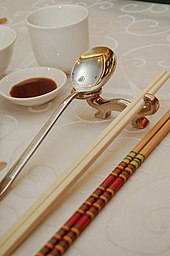
Imperial, royal and noble preferenceplayed a role in the changes in Chinese cuisines over time.[96]Because of imperial expansion and trading, ingredients and cooking techniques from other cultures were integrated into Chinese cuisines over time. The overwhelmingly large variety of Chinese cuisine comes mainly from the practice of the dynastic periods, whenemperorswould host banquets with over 100 dishes per meal.[97]A countless number of imperial kitchen staff andconcubineswere involved in the food preparation process. Over time, many dishes became part of the everyday citizen's cuisine. Some of the highest quality restaurants with recipes close to the dynastic periods include Fangshan restaurant inBeihai ParkBeijingand the Oriole Pavilion.[97]Arguably all branches ofHong Kong eastern styleare in some ways rooted from the original dynastic cuisines.
Manhan Quanxi,literallyManchu Han Imperial Feastwas one of the grandest meals ever documented in Chinese cuisine. It consisted of at least 108 unique dishes from theManchuandHan Chineseculture during theQing dynasty,and it is only reserved and intended for theemperors.The meal was held for three whole days, across six banquets. The culinary skills consisted of cooking methods from all overImperial China.[98]When theManchus conquered Chinaand founded theQing dynasty,the Manchu and Han Chinese peoples struggled for power. TheKangxi Emperorwanted to resolve the disputes so he held a banquet during his 66th birthday celebrations. The banquet consisted of Manchu and Han dishes, with officials from both ethnic groups attending the banquet together. After theWuchang Uprising,common people learned about the imperial banquet. The original meal was served in theForbidden CityinBeijing.[98]
Major subcultures
Chinese culture consists of many subcultures. In China, the cultural difference between adjacent provinces (and, in some cases, adjacent counties within the same province) can often be as big as than that between adjacent European nations.[99]Thus, the concept ofHan Chinese subgroups( hán tộc dân hệ / hán tộc dân hệ, literally "Han ethnic lineage" ) was born, used for classifying these subgroups within the greater Han ethnicity. These subgroups are, as a general rule, classified based on linguistic differences.
Using this linguistic classification, some of the well-known subcultures within China include:
North
- Hui culture
- Culture of Beijing( kinh )
- Culture of Shandong( lỗ / lỗ )
- Culture of Gansu
- Dongbei culture( đông bắc / đông bắc )
- Shaanxiculture
- Jin culture( tấn / tấn )[100][101][102]
- Zhongyuan culture( dự )
South
- Haipai culture( hải )
- Hakka culture( khách )
- Hokkien culture( mân )
- Hong Kong culture( cảng )
- Hubei culture( sở )
- Huizhou culture( huy )
- Hunanese culture( tương )
- Jiangxi culture( cống )
- Jiangnanculture
- Lingnan culture( việt / việt )
- Macanese culture
- Sichuanese culture( thục )
- Taiwanese culture( đài )
- Teochew culture( triều )
- Wenzhou culture( âu )
- Wuyue culture( ngô / ngô )
Gallery
-
A traditional red Chinese door withImperial guardian lionknocker
-
Journey to the West( tây du ký / tây du ký )
-
Xiquperformance
-
Lion dance( vũ sư )
-
Dragon dance( vũ long )
-
Taoist architecture in China
-
Wooden sculpture ofGuanyin
-
Que pillar gatesofChongqingthat once belonged to atemplededicated to theWarring States periodgeneralBa Manzi
-
Hair Ornament, China,c. 19th century
-
Koi Pondis a signature scenery depicted in Chinese gardens
-
Oolong tealeaves steeping in agaiwan
-
Ming tablein theVictoria and Albert Museum,1425–1436
-
Zhu-Ye-Qing-Tea
-
Dragon Tea Pot, Republic of China
-
Tea Pots, Republic of China
-
Laoshan green tea
-
Tea caddy, Chinese - Indianapolis Museum of Art
-
Chinese tea
-
Main hall and tea house in Dunedin Chinese Garden
-
Chinese Export—European Market, 18th century - Tea Caddy (lid)
-
Ancient China's Tea Pots
See also
- Bian Lian
- Chinese animation
- Chinese ancestral veneration
- Chinese art
- Chinese Buddhism
- Chinese cinema
- Chinese clothes
- Chinese food
- Chinese dance
- Chinese dragon
- Chinese drama
- Chinese festival
- Chinese folklore
- Chinese folk religion
- Chinese garden
- Chinese instrument
- Chinese jade
- Chinese literature
- Chinese marriage
- Chinese name
- Chinese opera
- Chinese orchestra
- Chinese paper cutting
- Chinese sphere of influence
- Chinese studies
- Color in Chinese culture
- Customs and etiquette in Chinese dining
- Go
- I Ching's influence
- Numbers in Chinese culture
- Peking opera
- Science and technology in China
- Taoism
- Tian-tsui
- Xiangqi
Notes
References
- ^"Chinese Dynasty Guide – The Art of Asia – History & Maps".Minneapolis Institute of Art.Archived fromthe originalon 6 October 2008.Retrieved10 October2008.
- ^"Guggenheim Museum – China: 5,000 years".Solomon R. Guggenheim Foundation&Solomon R. Guggenheim Museum.Archivedfrom the original on 9 October 2009.Retrieved10 October2008.
- ^Walker, Hugh Dyson (2012).East Asia: A New History.AuthorHouse. p. 2.
- ^Wong, David (2017)."Chinese Ethics".The Stanford Encyclopedia of Philosophy.Metaphysics Research Lab, Stanford University.Archivedfrom the original on 11 March 2017.Retrieved16 September2017.
- ^"Chinese Culture, Tradition, and Customs – Penn State University and Peking University".elements.science.psu.edu.Archived fromthe originalon 18 March 2019.Retrieved10 September2017.
- ^"Chinese Culture: Ancient China Traditions and Customs, History, Religion".www.travelchinaguide.com.Archivedfrom the original on 29 June 2017.Retrieved10 September2017.
- ^Executive Yuan, Taiwan (2016).The Republic of China Yearbook 2016.Archived fromthe originalon 18 September 2017.Retrieved8 September2017.[dead link]
- ^Population in brief 2015(PDF)(Report). National Population and Talent Division. Archived fromthe original(PDF)on 16 February 2016.Retrieved14 February2016.
- ^Guo Rongxing (2011).China's Multicultural Economies: Social and Economic Indicators.Springer. p. vii.ISBN978-1-4614-5860-9.Archivedfrom the original on 22 October 2023.Retrieved26 November2013.
- ^"Common traits bind Jews and Chinese".Asia Times Online. 10 January 2014. Archived from the original on 10 January 2014.Retrieved23 September2015.
{{cite web}}:CS1 maint: unfit URL (link) - ^Tseng, Wen-Shing; Wu, David (1985).Chinese culture and mental health.East-West Culture Learning Institute, John A. Burns School of Medicine. Orlando: Academic Press. p. 2.ISBN978-0-12-701630-6.
- ^Li, Deshun (2016).On Chinese Culture(1st ed. 2016 ed.). Singapore: Springer Singapore: Imprint: Springer. p. 5.ISBN978-981-10-0279-3.
- ^Robert Mortimer Marsh,Mandarins: The Circulation of Elites in China, 1600–1900,Ayer (June 1980), hardcover,ISBN0-405-12981-5
- ^The Cambridge History of China, Vol. 13, p. 30.
- ^Rui Wang,The Chinese Imperial Examination System(2013) p. 3.
- ^"Quảng đông tam bảo chi nhất hòa cán thảo"[One of the Three Treasures of Guangdong Grass].Huaxia.com.26 March 2009. Archived fromthe originalon 26 June 2009.Retrieved20 June2009.
- ^"1/4/2008 three treasures"(PDF).RTHK.org.Archived fromthe original(PDF)on 5 June 2011.Retrieved20 June2009.
- ^"Thuyết tam dữ tam bảo"[Say "Three" and "Three Treasures" ].Xinhuanet.com.19 March 2009. Archived fromthe originalon 18 July 2011.Retrieved20 June2009.
- ^Mente, Boye De. [2000] (2000). The Chinese Have a Word for it: The Complete Guide to Chinese thought and Culture. McGraw-Hill Professional.ISBN0-658-01078-6
- ^Alon, Ilan, ed. (2003), Chinese Culture, Organizational Behavior, and International Business Management, Westport, Connecticut: Praeger Publishers.
- ^abPollard, Elizabeth; Clifford; Robert; Rosenberg; Tignor (2011).Worlds Together Worlds Apart.New York, New York: Norton. p. 164.ISBN978-0-393-91847-2.
{{cite book}}:CS1 maint: multiple names: authors list (link) - ^abCreel (1970).What Is Taoism?.University of Chicago Press. pp. 48, 62–63.ISBN978-0-226-12047-8.Archivedfrom the original on 1 September 2023.Retrieved29 October2017.
- ^Benard, Elisabeth Anne (2010).Chinnamastā, the Aweful Buddhist and Hindu Tantric Goddess.Motilal Banarsidass Publishers.ISBN978-81-208-1748-7.Archivedfrom the original on 22 October 2023.Retrieved29 October2017.
- ^Ching, Julia; Guisso, R. W. L. (1991).Sages and Filial Sons: Mythology and Archaeology in Ancient China.Chinese University Press.ISBN978-962-201-469-5.Archivedfrom the original on 22 October 2023.Retrieved29 October2017.
- ^Bary, Theodore de."Constructive Engagement with Asian Values".Archived fromthe originalon 11 March 2005..Columbia University.
- ^Yao (2000).An Introduction to Confucianism.Cambridge University Press. pp. 38–47.ISBN978-0-521-64430-3.Archivedfrom the original on 26 April 2023.Retrieved29 October2017.
- ^Rickett, Guanzi – "all early Chinese political thinkers were basically committed to a reestablishment of the golden age of the past as early Zhou propaganda described it."
- ^"Chinese philosophy"Archived2 May 2015 at theWayback Machine,Encyclopædia Britannica, Retrieved 4 June 2014
- ^Graham, A.C.,Disputers of the Tao: Philosophical Argument in Ancient China(Open Court 1993).Archived20 January 2012 at theWayback MachineISBN0-8126-9087-7
- ^"Zou Yan".Encyclopædia Britannica.Archivedfrom the original on 26 April 2015.Retrieved1 March2011.
- ^Wurm, Li, Baumann, Lee (1987)[full citation needed]
- ^Ramsey, S. Robert (1987).The Languages of China.Princeton, New Jersey:Princeton University Press.pp. 3–16.ISBN978-0-691-01468-5.
- ^Stanley-Baker (2010)[full citation needed]
- ^Thư being here used as in giai thư / giai thư, etc, and meaning "writing style".
- ^Wang Li; et al. (2000).Vương lực cổ hán ngữ tự điển.Beijing: Trung hoa thư cục. p. 1118.ISBN7-101-01219-1.
- ^"Shodo and Calligraphy".Vincent's Calligraphy.Archivedfrom the original on 6 May 2020.Retrieved28 May2016.
- ^Shu Xincheng thư tân thành, ed. Cihai ( từ hải "Sea of Words" ). 3 vols. Shanghai: Zhonghua. 1936.
- ^Jing-Schmidt, p. 256[full citation needed]
- ^abcParagraph 15 in Paul W. Kroll "Poetry of the T'ang Dynasty", chapter 14 in Mair 2001.
- ^abcdeParagraph 16 in Paul W. Kroll "Poetry of the T'ang Dynasty", chapter 14 in Mair 2001.
- ^Paragraph 17 in Paul W. Kroll "Poetry of the T'ang Dynasty", chapter 14 in Mair 2001.
- ^Frankel, p. 216[full citation needed]
- ^Davis, p. lxvii[full citation needed]
- ^Zhang, pp. 76–80[full citation needed]
- ^Yip, pp. 306–308[full citation needed]
- ^Shep, Sydney J. (2011), "Paper and Print Technology",The Encyclopedia of the Novel,Encyclopedia of Literature,Vol. 2,John Wiley & Sons,p. 596,ISBN978-1-4051-6184-8,archivedfrom the original on 22 October 2023,retrieved30 October2017,
Dream of the Red Chamber... is considered one of China's four great classical novels...
- ^Li Xiaobing (2016), "Literature and Drama",Modern China,Understanding Modern Nations, Sta Barbara: ABC-CLIO, p.269,ISBN978-1-61069-626-5,archivedfrom the original on 22 October 2023,retrieved6 June2020,
Romance of the Three Kingdoms,Outlaws of the Marsh,A Dream of Red Mansions,andJourney to the Westhave become the Four Great Classic Novels of Chinese literature.
- ^Cline, Eric; Takács, Sarolta Anna, eds. (2015), "Language and Writing: Chinese Literature",The Ancient World,Vol. V,Routledge, p.508,ISBN978-1-317-45839-5,archivedfrom the original on 22 October 2023,retrieved6 June2020,
Chinese authors finally produced novels during the Yuan dynasty... when two of China's 'Four Classic Novels' –Water MarginandRomance of the Three Kingdoms– were published.
- ^Ropp, 1990, p. 310-311[full citation needed]
- ^Ropp, 1990, p. 311[full citation needed]
- ^Andrew H. Plaks,Four Masterworks of the Ming Novel(Princeton, New Jersey: Princeton University Press, 1987), esp. pp. 497–98.
- ^"Chinese lantern".The Free Dictionary.Archivedfrom the original on 18 May 2014.Retrieved18 May2014.
- ^"articles – brief history of fans".aboutdecorativestyle.com.Archivedfrom the original on 22 June 2017.Retrieved8 January2019.
- ^"Chinese Hand Fans".hand-fan.org.Archivedfrom the original on 2 February 2019.Retrieved8 January2019.
- ^abGrove[full citation needed]
- ^Grove; Cinnabar[full citation needed]
- ^Watt and Ford, p. 3[full citation needed]
- ^Watt and Ford, pp. 6–7 (p. 7 quoted)[full citation needed]
- ^"armour / khôi giáp (MAS 621)".Collection online.The British Museum. See "Curator's comments". Archived fromthe originalon 7 November 2017.
- ^Kuwayama, pp. 13–14[full citation needed];Rawson, p. 175[full citation needed];Grove, "Tang"[full citation needed]
- ^Watt and Ford, p. 7[full citation needed];Rawson, p. 175[full citation needed]
- ^Kuwayama, pp. 13–14[full citation needed]
- ^Watt and Ford, pp. 26–27, 46–61, 60 for the use of green[full citation needed];Rawson, p. 178[full citation needed];Grove, "Song"[full citation needed];Kuwayama, pp. 13–17 on the Song[full citation needed]
- ^abcHandler, Sarah (2007).Austere luminosity of Chinese classical furniture.University of California Press. pp. 268–271, 275, 277.ISBN978-0-520-21484-2.Archivedfrom the original on 22 October 2023.Retrieved30 October2017.
- ^abcdMazurkewich, Karen; Ong, A. Chester (2006).Chinese Furniture: A Guide to Collecting Antiques.Tuttle Publishing. pp. 144–146.ISBN978-0-8048-3573-2.Archivedfrom the original on 22 October 2023.Retrieved30 October2017.
- ^abcdNeedham, Joseph;Tsien, Tsuen-hsuin(1985).Paper and printing, Volume 5.Cambridge University Press. p. 120.ISBN978-0-521-08690-5.Archivedfrom the original on 22 October 2023.Retrieved30 October2017.
- ^Lee, O-Young; Yi, Ŏ-ryŏng; Holstein, John (1999).Things Korean.Tuttle Publishing. p. 135.ISBN978-0-8048-2129-2.Archivedfrom the original on 22 October 2023.Retrieved30 October2017.
- ^abvan Gulik, Robert Hans (1981).Chinese pictorial art as viewed by the connoisseur: notes on the means and methods of traditional Chinese connoisseurship of pictorial art, based upon a study of the art of mounting scrolls in China and Japan.Hacker Art Books. p. 159.ISBN978-0-87817-264-1.Archivedfrom the original on 22 October 2023.Retrieved30 October2017.
- ^Trương thế nam (Zhang Shi'nan) (1200s)."5".Du hoạn kỷ văn (yóuhuàn jìwén)(in Chinese).Archivedfrom the original on 6 February 2017.Retrieved30 October2017.
Khoản vị âm tự, thị ao nhập giả, khắc họa thành chi(kuǎnare inscriptions that arecounter-relief,achieved by carving)
- ^Clunas, Craig (1997).Pictures and visuality in early modern China.London:Reaktion Books.p. 61.ISBN978-1-86189-008-5.Archivedfrom the original on 22 October 2023.Retrieved30 October2017.
- ^abcFiero, Gloria K.The Humanistic Tradition6th Ed, Vol. I. McGraw-Hill, 2010.
- ^Pope-Henessey, Chapter II.[full citation needed]
- ^Pope-Henessey, Chapter IV.[full citation needed]
- ^William Watson; Chuimei Ho (2007).Arts of China, 1600–1900.Yale University Press. p. 77.ISBN978-0-300-10735-7.Archivedfrom the original on 22 October 2023.Retrieved30 October2017.
- ^Ingersoll, Ernest; et al. (2013).The Illustrated Book of Dragons and Dragon Lore.Chiang Mai: Cognoscenti Books.
- ^"qilin (Chinese mythology)".Encyclopædia Britannica.Archivedfrom the original on 19 October 2011.Retrieved24 July2011.
- ^"Chinese Literature – Chunqiu-Zuozhuan xuân thu tả truyện, Gongyangzhuan công dương truyện, Guliangzhuan cốc lương truyện (www.chinaknowledge.de)".Archivedfrom the original on 6 February 2007.Retrieved8 January2019.
- ^Cổ kiến thượng đích chủ yếu trang sức văn dạng —— kỳ lân cổ kiến viên lâm kỹ thuật - tác giả: Từ hoa đangArchived30 September 2007 at theWayback Machine
- ^zh:s: Sử ký / quyển 028
- ^abMichel Baridon,Les Jardins – paysagistes, jardiners, poḕts.p. 348
- ^A.H. Longhurst (1995).Story of the Stupa.Asian Educational Services. pp. 17–.ISBN978-81-206-0160-4.Archivedfrom the original on 22 October 2023.Retrieved1 November2017.
- ^Michel Baridon,Les Jardins - paysagistes, jardiners, poḕts.p. 348
- ^Feng Chaoxiong,The Classical Gardens of Suzhou,preface, and Bing Chiu,Jardins de Chine, ou la quete du paradis,Editions de La Martiniere, Paris 2010, p. 10–11.
- ^Tong Jun, Records of Jiang Gardens, cited in Feng Chanoxiong,The Classical Gardens of Suzhou.
- ^abChe Bing Chiu, "Jardins de Chine, ou la quete du paradis"
- ^Ma, Guansheng (December 2015)."Food, eating behavior, and culture in Chinese society".Journal of Ethnic Foods.2(4): 195–199.doi:10.1016/j.jef.2015.11.004.
- ^"Four Major Cuisines in China".CITS.Archivedfrom the original on 11 January 2017.Retrieved10 January2017.
- ^"Eight Cuisines of China – Shandong & Guangdong".TravelChinaGuide.com.Archivedfrom the original on 28 August 2011.Retrieved1 November2017.
- ^"Fujian Cuisine.Beautyfujian.comArchived10 July 2011 at theWayback Machine.Accessed June 2011.
- ^This standard starts fromTang dynastyin the 6th century byBai Juyifrom thePreface ofLycheeDiagram:After leaving branch...for four and five days, the color, smell and taste (of lychee) will be gone. (《 lệ chi đồ tự 》: “Nhược ly bổn chi...... Tứ ngũ nhật ngoại, sắc, hương, vị tẫn khứ hĩ”. )
- ^E., Strassberg, Richard (1994).Inscribed landscapes: travel writing from imperial China.Berkeley: University of California Press.ISBN978-0-520-91486-5.OCLC44957693.
{{cite book}}:CS1 maint: multiple names: authors list (link) - ^Houyuan Lu; et al. (7 January 2016)."Earliest tea as evidence for one branch of the Silk Road across the Tibetan Plateau".Nature.6:18955.Bibcode:2016NatSR...618955L.doi:10.1038/srep18955.PMC4704058.PMID26738699.
- ^Liu, Tong (2012).Chinese Tea.The United States of America: Cambridge University Press. p. 1.ISBN978-0-521-18680-3.
- ^"Tea and the Chinese way of life".radio86.com. Archived fromthe originalon 16 August 2011.Retrieved9 January2012.
- ^"Notes on Chinese Culture – Food and Drinks (08) – Chinese Tea".dict.cn. Archived fromthe originalon 4 August 2012.Retrieved9 January2012.
- ^Từ văn uyển (2005).Origin of Confucian cuisine.Thanh hoa đại học xuất bản xã hữu hạn công tư.ISBN978-7-81082-370-8.Archivedfrom the original on 22 October 2023.Retrieved1 January2006.
- ^abKong, Foong, Ling. [2002]. The Food of Asia. Tuttle Publishing.ISBN0-7946-0146-4
- ^abHoover, Michael. Stokes, Lisa, Odham. (1999). City on Fire: Hong Kong Cinema. Verso publishing.ISBN1-85984-203-8
- ^"Chinese Culture: Customs & Traditions of China".Live Science.Archivedfrom the original on 9 September 2017.Retrieved9 September2017.
- ^Tấn ngữ đích sử dụng phạm vi dữ lịch sử khởi nguyên[permanent dead link]
- ^"Tấn ngữ thị trung quốc bắc phương đích duy nhất nhất cá phi quan thoại phương ngôn, đãn thị phủ quy chúc quan thoại".Archived fromthe originalon 22 March 2021.Retrieved7 September2017.
- ^Sơn tây phương ngôn dữ sơn tây văn hóa[permanent dead link]
External links
- Aspect of Chinese culture, Chang Zonglin. Li Xukui,ISBN978-7-302-12632-4,Tsinghua University Press
- Exploring Ancient World Cultures – Ancient China, University of Evansville



